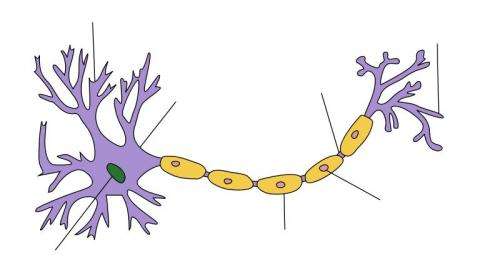Myelin sheath. Credit: Wikipedia.
(Medical Xpress)—A mixed background group of US researchers has found in studying chimpanzee brains, that development of myelin, the fatty sheath that covers the connections between nerve cells, occurs at a different rate than for humans, and as they write in their paper published in the Proceedings of the National Academy of Sciences, the differences might account for the greater instance of mental disorders in people than in both chimpanzees and other primates, such as macaques.
Myelin is a fatty coating that covers axons, the connections between nerve cells, rather like the plastic sheathing that covers household electrical wiring. Its purpose is to help control the flow of electrical signals between neurons. Many disorders come about in people who experience demyelination, or the loss of myelin, most notoriously, multiple sclerosis. More research recent has suggested that problems with myelin might also be at the root of some mental illnesses, such as schizophrenia, bi-polar disorder or chronic depression. This new study bolsters such thinking as the team has found that myelin development in human beings is markedly different than it is for chimpanzees.
Prior research has shown that myelin development in other primates, such as macaques occurs at a different rate than for humans, but until now, a similar study on chimpanzees had not been undertaken due to the difficulty in obtaining brain samples from them. In this new effort, the team was able to examine the brains of 20 chimps that had died due to non-research related causes and in so doing they found that myelin development occurred at very nearly the same rate as for other primates, which indicates that there is a clear difference between the rates of development in humans versus most, if not all, other primates.
Human babies are born with almost no myelin at all. Shortly after birth, they have a spurt of sorts, with a lot of developing occurring and continuing on slowly thereafter for some thirty years. Other primates, in contrast, begin developing myelin while still in the womb and it keeps up just until the animal reaches sexual maturity, at which point, it stops completely.
The researchers speculate that the differences in myelin development may explain some of the unique mental abilities of people, as being born with little to no myelin, allows for more openness to learning from the environment as opposed to relying on information passed on through genes. They also suggest those same differences might be putting people at more of a risk of developing mental illness though, as the possibility of something going wrong during the process grows greater over longer periods of time.
More information: Prolonged myelination in human neocortical evolution, PNAS, Published online before print September 24, 2012, doi: 10.1073/pnas.1117943109
Abstract
Nerve myelination facilitates saltatory action potential conduction and exhibits spatiotemporal variation during development associated with the acquisition of behavioral and cognitive maturity. Although human cognitive development is unique, it is not known whether the ontogenetic progression of myelination in the human neocortex is evolutionarily exceptional. In this study, we quantified myelinated axon fiber length density and the expression of myelin-related proteins throughout postnatal life in the somatosensory (areas 3b/3a/1/2), motor (area 4), frontopolar (prefrontal area 10), and visual (areas 17/18) neocortex of chimpanzees (N = 20) and humans (N = 33). Our examination revealed that neocortical myelination is developmentally protracted in humans compared with chimpanzees. In chimpanzees, the density of myelinated axons increased steadily until adult-like levels were achieved at approximately the time of sexual maturity. In contrast, humans displayed slower myelination during childhood, characterized by a delayed period of maturation that extended beyond late adolescence. This comparative research contributes evidence crucial to understanding the evolution of human cognition and behavior, which arises from the unfolding of nervous system development within the context of an enriched cultural environment. Perturbations of normal developmental processes and the decreased expression of myelin-related molecules have been related to psychiatric disorders such as schizophrenia. Thus, these species differences suggest that the human-specific shift in the timing of cortical maturation during adolescence may have implications for vulnerability to certain psychiatric disorders.
Journal information: Proceedings of the National Academy of Sciences
© 2012 Medical Xpress



















